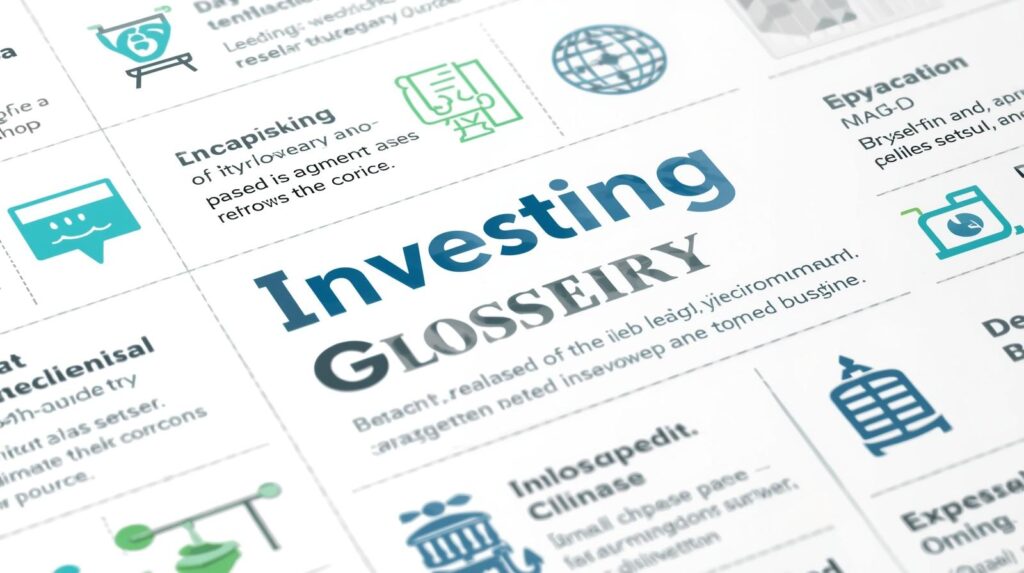By The Digital Hustle Hub
When I first tossed $100 from a Fiverr writing gig into the stock market, I was clueless—terms like “dividend yield” or “market cap” sounded like a secret code I’d never crack. I’d sit there, scrolling through X posts or YouTube tutorials, feeling like I was drowning in jargon. If you’re a young pro or gig worker starting out, you know the vibe: you want to grow your money, but the lingo’s a brick wall. In 2025, with markets jumping from crypto rallies to green energy bets and inflation biting at 3-4%, understanding the basics is your edge. That’s why I created a free Investing Glossary PDF—30+ terms to make investing feel less like a foreign language and more like a tool you can wield.
This article’s your guide to why this PDF’s a must-have, what’s inside, how to use it, and a real story from a friend who went from lost to confident. I’ve formatted it for easy WordPress posting, because you’re probably squeezing this read between hustle tasks. Whether you’ve got $50 from an Etsy sale or $200 from tutoring, this glossary will help you navigate apps, blogs, and tax forms without the headache. It’s not advice—check with a pro—but it’s your cheat sheet to investing smarter. Let’s break down the wall and get you building wealth.
Why You Need an Investing Glossary in 2025
If you’re juggling a day job and side gigs (like 60%+ of us, per recent stats), every dollar’s a hustle. But markets are wild right now—S&P’s up 12% this year, crypto’s volatile, and tax rules mean gig earnings over $600 (IRS) or £1,000 (HMRC) are tracked. Problem is, 70% of new investors get tripped up by terms like “ETF” or “capital gains,” leading to bad moves or just giving up. A glossary is like a pocket translator, turning confusion into clarity so you can pick stocks, dodge hype, or prep for taxes. My friends went from “What’s a bond?” to $1,500 portfolios in a year just by getting the lingo down. This free PDF’s your first step to that kind of win.

What’s Packed in the Investing Glossary PDF
This 10-page PDF crams in 30+ terms, each with a simple definition, a real-world example, and a note on why it matters for you. It’s built for hustlers—short, clear, no Wall Street nonsense. Here’s a taste of five terms you’ll find:
- Dividend: Cash a company pays you for owning its stock, often every quarter. Example: You’ve got 20 shares of a stock paying $0.50/share; you pocket $10. Why it matters: Extra cash to reinvest or spend, like a mini paycheck.
- ETF (Exchange-Traded Fund): A bundle of stocks or bonds you buy like a single stock. Example: Drop $50 on VOO to own a piece of 500 big US companies. Why it matters: Spreads risk, cheap fees, perfect for beginners.
- P/E Ratio (Price-to-Earnings): Stock price divided by its earnings per share. Example: A $200 stock earning $10/share has a 20 P/E. Why it matters: Helps you spot if a stock’s overpriced or a bargain.
- Capital Gains: Profit when you sell an asset for more than you paid. Example: Buy a crypto coin at $100, sell at $150, pocket $50. Why it matters: Taxable at 20%, so plan for the IRS or HMRC.
- Bull Market: When stocks climb 20%+ from a low point. Example: Nasdaq jumps from 12,000 to 14,400. Why it matters: Good time to buy or hold for growth.
The full PDF dives deeper—stocks, crypto, bonds, even tax terms—with simple visuals to make it stick. It’s like a crash course you can carry in your pocket.
How to Make the Most of the Investing Glossary PDF
Grab the PDF (link below) and keep it on your phone for quick lookups while you’re scrolling X, watching tutorials, or checking your brokerage app. Here’s how to put it to work:
- Before You Invest: Look up “expense ratio” or “diversification” when picking funds on Fidelity. Keeps you from buying high-fee duds.
- While Researching: Decode terms like “HODL” or “yield” from Reddit or blogs to avoid falling for hype.
- For Taxes: Check “capital gains” or “dividend income” to prep for gig income filings without stress.
- On the Go: Flip through it during lunch breaks to build confidence. I pull mine up before trading on Robinhood.
You can print it for scribbling notes or share it with your hustle squad—it’s free, no email traps.
A Story That Proves It Works
My buddy Jake, a barista pulling $400/month from Etsy sales, used to glaze over when he heard “volatility” or “asset allocation” on investing podcasts. I sent him an early version of this glossary, and he kept it open while researching. In four months, he went from nervous to throwing $200 into an ETF, earning $10 in dividends already. “It’s like someone handed me a market dictionary,” he told me over beers. His $200’s now $240, and he’s eyeing a Roth IRA next—all because he wasn’t scared off by the jargon.
Why This PDF Beats Random Web Searches
Googling terms is a time-suck—half the results are clickbait or too technical. This glossary’s different: it’s made for gig workers and young pros, focused on 2025’s hot spots like crypto ETFs and AI stocks. It’s ad-free, no sign-up nonsense, and packs a year of my own trial-and-error (like when I didn’t know “stop-loss” and sold low). At 10 pages, it’s quick but thorough, saving you from endless tabs. Download it, and you’re ready to roll, Wi-Fi or not.
Download Your Free Investing Glossary PDF
Ready to talk investing like you’ve been at it for years? Snag the Investing Glossary PDF below and keep it handy for your next trade or tax season. It’s free, built for hustlers, and ready to make 2025 your year to grow wealth confidently.
[Download Investing Glossary PDF Here] (Note: Link placeholder—PDF hosted on The Digital Hustle Hub site for instant access.)
Got a term you’re stuck on? Drop it in the comments, and let’s sort it out together.
Written by Mudassar Ali — Founder of The Digital Hustle Hub



